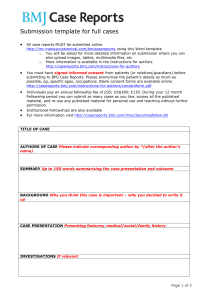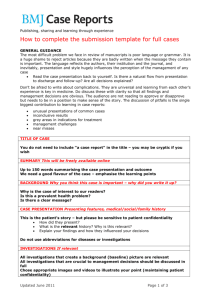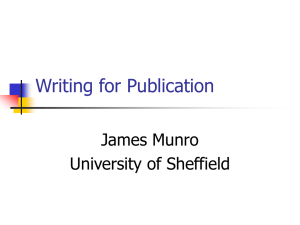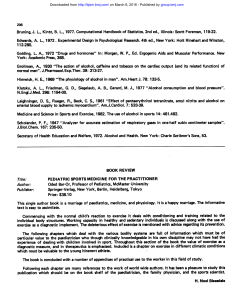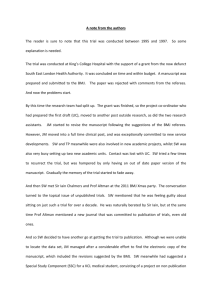Reason for optimism Please share
advertisement
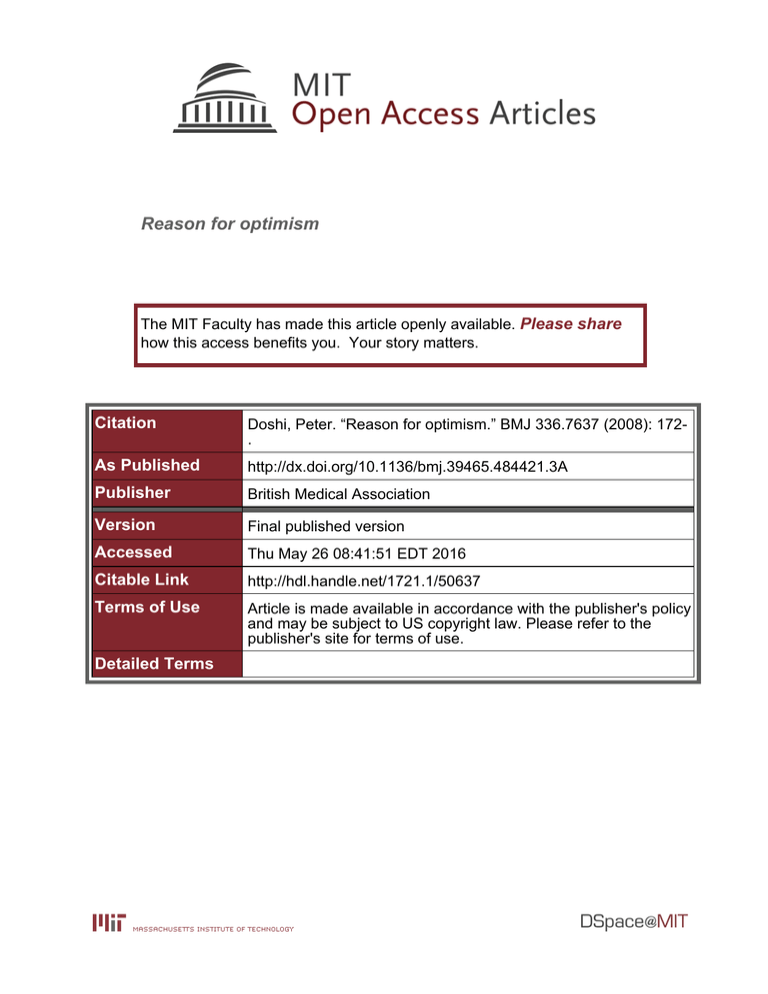
Reason for optimism The MIT Faculty has made this article openly available. Please share how this access benefits you. Your story matters. Citation Doshi, Peter. “Reason for optimism.” BMJ 336.7637 (2008): 172. As Published http://dx.doi.org/10.1136/bmj.39465.484421.3A Publisher British Medical Association Version Final published version Accessed Thu May 26 08:41:51 EDT 2016 Citable Link http://hdl.handle.net/1721.1/50637 Terms of Use Article is made available in accordance with the publisher's policy and may be subject to US copyright law. Please refer to the publisher's site for terms of use. Detailed Terms Downloaded from bmj.com on 13 May 2008 Reason for optimism Peter Doshi BMJ 2008;336;172doi:10.1136/bmj.39465.484421.3A Updated information and services can be found at: http://bmj.com/cgi/content/full/336/7637/172 These include: References Rapid responses Email alerting service This article cites 3 articles, 2 of which can be accessed free at: http://bmj.com/cgi/content/full/336/7637/172#BIBL You can respond to this article at: http://bmj.com/cgi/eletter-submit/336/7637/172 Receive free email alerts when new articles cite this article - sign up in the box at the top left of the article Notes To order reprints follow the "Request Permissions" link in the navigation box To subscribe to BMJ go to: http://resources.bmj.com/bmj/subscribers letters Downloaded from bmj.com on 13 May 2008 3 4 koji sasahara/ap 5 Preventing flu-like illness Reason for optimism The US Centers for Disease Control and Prevention (CDC) claims that the single best way to prevent seasonal flu is to get vaccinated each year.1 Such confidence in influenza vaccines seems misplaced for two reasons. Firstly, if CDC viral surveillance data are correct, then in recent years true influenza viruses have caused an average of only 12% of influenza-like illness2 (the syndrome the public thinks of as “flu” and, most critically, the syndrome the public is trying to avoid). Since influenza vaccine does not work against non-influenza viruses,3 how can the agency responsibly claim vaccines are the best way to prevent seasonal flu? Secondly, the track record for influenza vaccination is not stellar. Over the past years, numerous reviews have shown that the benefits of influenza vaccination have been overstated— most importantly in elderly people, the group most needing protection. With all the focus on influenza instead of influenza-like illness, we are missing the target, pursuing a health policy that has probably placed a prolonged undue reliance on vaccination and other pharmaceutical measures—and prematurely and (we now know) illegitimately demoting the role of physical barriers such as hand washing and masks. Official US recommendations for the prevention and control of influenza are 25 000 words long.4 Only one sentence of that document mentions non-pharmaceutical interventions, only to brush them off as having “not been studied adequately.” Jefferson et al have reviewed the literature—and the evidence gives reason for optimism.5 Will policy change? Peter Doshi graduate student, Massachusetts Institute of Technology, Cambridge, MA, USA pnd@mit.edu Competing interests: PD knows some of the authors and had a chance to read and comment on the draft manuscript prior to publication. 1 2 172 Centers for Disease Control and Prevention. Preventing seasonal flu. www.cdc.gov/flu/protect/preventing.htm. Thompson WW, Shay DK, Weintraub E, et al. Mortality associated with influenza and respiratory syncytial virus in the United States. JAMA 2003;289:179-186. (Table 1.) Centers for Disease Control and Prevention. Key facts about influenza and influenza vaccine. 2007. CDC. Prevention and control of influenza: Recommendations of the Advisory Committee on Immunization Practices (ACIP). Morb Mort Wkly Rep 2007;56(RR06):1-54. Jefferson T, Foxlee R, Del Mar C, Dooley L, Ferroni E, Hewak B, et al. Physical interventions to interrupt or reduce the spread of respiratory viruses: systematic review. BMJ 2008;336:77-80. (12 January.) Home haemodialysis UK nephrology misunderstood Blagg criticises the UK renal community for lagging behind some other high income countries in the proportion of patients receiving home haemodialysis (HD).1 A generation of UK nephrologists was forced, by lack of facilities, to give patients a stark choice between home HD, home peritoneal dialysis, or death. As hospital and satellite dialysis facilities have expanded, the proportion of patients receiving home based treatment has rightly reduced. Whether that reduction is due to poor availability or to free choice between home HD and other options remains open to question. Many patients perceive no advantage of home HD when the alternative is a local satellite dialysis unit. Patients receiving satellite or hospital based HD can also control many aspects of their own treatment. What the “correct” proportion should be cannot be based on comparisons with Australia and New Zealand, where for reasons of geographical dispersion, home HD remains the only viable option for many patients. Provision of home HD requires a community team of nurses and technologists. Some UK units therefore choose to refer their patients to a neighbouring unit for home HD rather than run their own home HD programme; this is not evidence in itself that suitable patients are not offered home HD. Policy in the UK supporting the use of home HD is set by the Departments of Health and the National Institute for Health and Clinical Excellence (NICE). UK nephrologists fully agree that home HD should be offered to all suitable patients, but they have doubts that the NICE target—15% of all HD should be performed at home—is based on good evidence. Similarly, whereas they are enthusiastic about daily short hours or nightly long hours HD, this treatment is not endorsed by national policy or by NICE— largely because there is not, at this point, sound evidence of benefit. Charles R V Tomson consultant renal physician, Southmead Hospital, North Bristol NHS Trust, Bristol BS10 5NB charlie.tomson@nbt.nhs.uk On behalf of the trustees of the Renal Association Competing interests: None declared. 1 Blagg CR. Home haemodialysis. BMJ 2008;336:3-4. (5 January.) Missing facts, different countries Blagg states that home haemodialysis (HD) is cost effective.1 In the United States, where there is less likelihood of receiving a cadaveric transplant than in the United Kingdom (45% v 30%), the economics are different. In the United Kingdom the break even point on the set up and running costs of home HD v in-centre HD is about two years. Analysis of data from the UK Renal Registry shows that within 20 months of starting, half of the patients receiving home HD would have received a kidney transplant. This makes the cost neutral point towards 3-4 years. It will always be difficult to show that home HD improves survival as patients on the home HD programme in any renal unit are always highly selected. They are unlikely to have any comorbid conditions and have good fistulas (not central lines). It is difficult even with age matching to allow for all these selection factors in matching a similar cohort. Short daily dialysis is a separate (and more costly) entity than standard home HD requiring specific equipment and is currently undergoing evaluation in the UK. The high rates of home HD in New Zealand are related to some specific factors in their healthcare system but do not imply a free choice. The UK also has a larger peritoneal dialysis programme than the US and other EU countries. In those countries some patients receiving home HD may rather have chosen peritoneal dialysis. All these factors increase the complexity of any international comparison. David Ansell director, UK Renal Registry, Southmead Hospital, Bristol BS10 5 NB david.ansell@nbt.nhs.uk Competing interests: None declared. 1 Blagg CR. Home haemodialysis. BMJ 2008;336:3-4. (5 January.) Author’s reply Selection bias has an important role, but almost all reports on quality of life have shown the benefits of home haemodialysis (HD), and patients are vocal about the advantages they have experienced. Even if survival is no better, surely willing and suitable patients should have access to a treatment that provides, for example, opportunity for longer or more frequent dialysis, improved quality of life, rehabilitation, and flexibility of scheduling? In terms of urbanisation, Australia ranks 19th in the world (91% urbanisation) compared with the UK, which is 20th (90% urbanisation), and New Zealand, which is 32nd (86% urbanisation).1 On the basis of their registries, the rates per million for HD, peritoneal dialysis, and transplantation are also similar—303, 85, and 317 in the UK; 330, 88, and 322 in Australia; and 277, 176, and 302 in New Zealand. BMJ | 26 January 2008 | Volume 336

